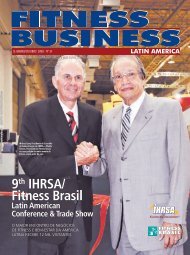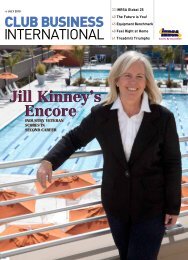Augie In Action! Augie In Action! - Ihrsa
Augie In Action! Augie In Action! - Ihrsa
Augie In Action! Augie In Action! - Ihrsa
You also want an ePaper? Increase the reach of your titles
YUMPU automatically turns print PDFs into web optimized ePapers that Google loves.
IT MAY NOT BE WHAT MOST CLUB OPERATORS THINK OF AS A WELLNESS CENTER. Healthtrax<br />
Fitness and Wellness, a chain of medically-affiliated fitness centers based in Glastonbury,<br />
Connecticut, operates much like a traditional IHRSA club, with the same best-of-breed fitness<br />
equipment and programs that have become the industry standard.<br />
But what makes its locations special, what makes them different, is exactly that—their physical<br />
locations. They are not separate, free-standing clubs; they are designed as an integral piece of a healthcare<br />
community, well-positioned as part of a network of health and wellness practitioners of every<br />
sort and specialty, from major hospital partners to individual chiropractors, all in one location.<br />
The Healthtrax Fitness and Wellness model, which first emerged in Hanover, Massachusetts, in<br />
1990, is “a new breed of real estate,” explains Bob Stauble, the director of new business and sales<br />
for Healthtrax. “We’ve branded the building as a community wellness center. It’s a medical building<br />
that has a 35,000-square-foot fitness center as its anchor.”<br />
Eighteen years and 15 community wellness centers later, Healthtrax has perfected a formula that<br />
makes clever and effective use of medical affiliations, collective marketing, and strategic branding—<br />
resulting in high member retention, consistent profits, and continued growth.<br />
Wellness from the ground up<br />
<strong>In</strong> the 1980s, before the days of healthcare reform, hospitals were relatively well-funded and<br />
even expanded beyond their core businesses. <strong>In</strong> some cases, such as in the Chicago area, they<br />
built oversized health clubs on their medical campuses that performed quite well, when<br />
compared to other hospital departments. But the downfall of the now-defunct hospital fitness<br />
center model was that many of the institutions often applied their not-for-profit mentality to what<br />
most believe should be managed as a for-profit business.<br />
“The problem was that, in one example, they weren’t charging themselves rent, and they were just<br />
looking at net income, not EBITDA, not cash flow—so, while it appeared that they were generating a<br />
half a million dollars in profits, by IHRSA’s standards, they were actually losing money to the tune of a<br />
quarter-million dollars a year,” explains Stauble, who watched the phenomenon closely.<br />
It was during this period that Healthtrax, which had a handful of New England clubs in its<br />
portfolio, began to study the medical fitness model carefully, and its current business plan began<br />
to take shape. ><br />
By Jennifer H. Mc<strong>In</strong>erney<br />
Healthtrax has<br />
successfully forged a<br />
rewarding medical link<br />
www.ihrsa.org | MARCH 2008 | Club Business <strong>In</strong>ternational 85
















